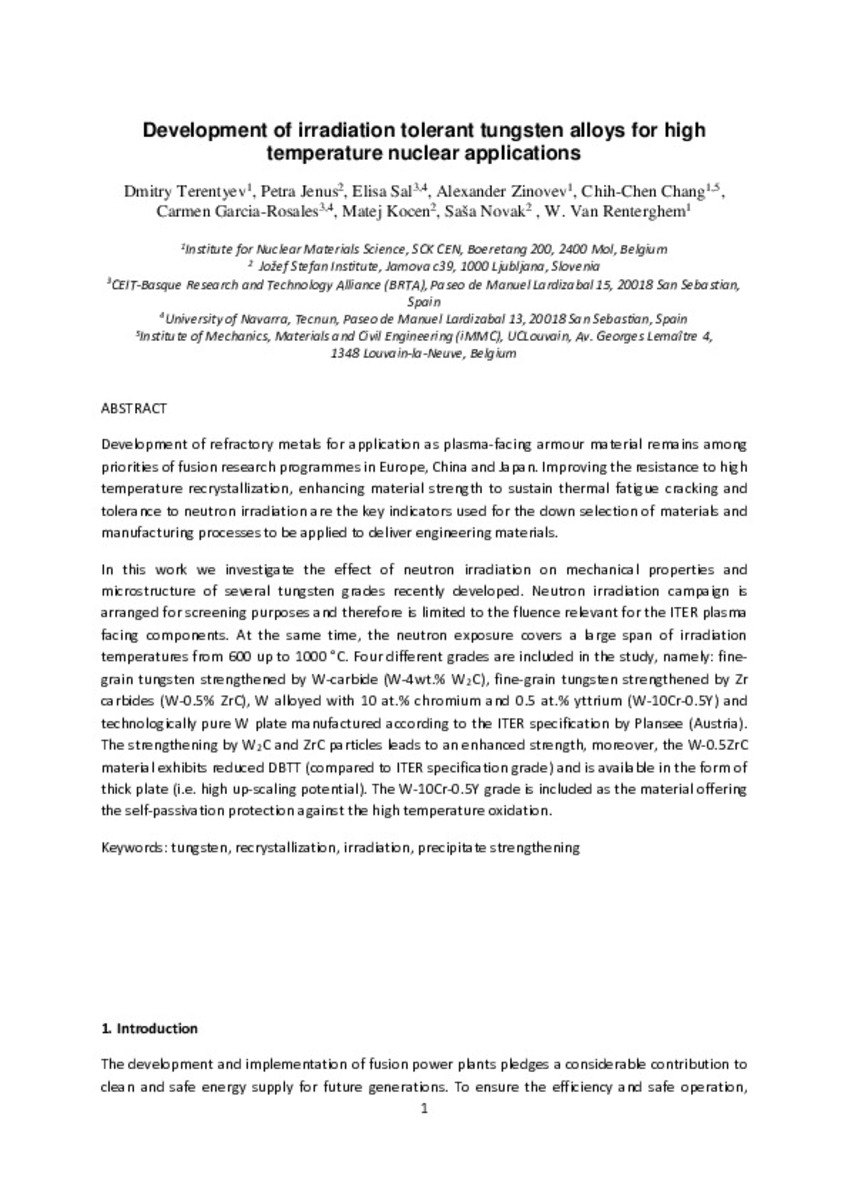Full metadata record
| DC Field | Value | Language |
|---|---|---|
| dc.creator | Terentyev, D. (Dmitry) | - |
| dc.creator | Jenus, P. (Petra) | - |
| dc.creator | Sal-Broco, E. (Elisa) | - |
| dc.creator | Zinovev, A. (Aleksandr) | - |
| dc.creator | Kocen, M. (Matej) | - |
| dc.creator | Novak, S. (Sasa) | - |
| dc.creator | Garcia-Rosales, C. (Carmen) | - |
| dc.date.accessioned | 2024-01-11T11:26:34Z | - |
| dc.date.available | 2024-01-11T11:26:34Z | - |
| dc.date.issued | 2022-08 | - |
| dc.identifier.citation | Terentyev, D., Jenus, P., Sal, E., Zinovev, A., Chang, C. C., Garcia-Rosales, C., ... & Van Renterghem, W. (2022). Development of irradiation tolerant tungsten alloys for high temperature nuclear applications. Nuclear Fusion, 62(8), 086035. | es_ES |
| dc.identifier.issn | 0029-5515 | - |
| dc.identifier.uri | https://hdl.handle.net/10171/68277 | - |
| dc.description.abstract | Development of refractory metals for application as plasma-facing armour material remains among priorities of fusion research programmes in Europe, China and Japan. Improving the resistance to high temperature recrystallization, enhancing material strength to sustain thermal fatigue cracking and tolerance to neutron irradiation are the key indicators used for the down selection of materials and manufacturing processes to be applied to deliver engineering materials. In this work we investigate the effect of neutron irradiation on mechanical properties and microstructure of several tungsten grades recently developed. Neutron irradiation campaign is arranged for screening purposes and therefore is limited to the fluence relevant for the ITER plasma facing components. At the same time, the neutron exposure covers a large span of irradiation temperatures from 600 up to 1000 degrees C. Four different grades are included in the study, namely: fine-grain tungsten strengthened by W-carbide (W-4wt.% W2C), fine-grain tungsten strengthened by Zr carbides (W-0.5% ZrC), W alloyed with 10 at.% chromium and 0.5 at.% yttrium (W-10Cr-0.5Y) and technologically pure W plate manufactured according to the ITER specification by Plansee (Austria). The strengthening by W2C and ZrC particles leads to an enhanced strength, moreover, the W-0.5ZrC material exhibits reduced DBTT (compared to ITER specification grade) and is available in the form of thick plate (i.e. high up-scaling potential). The W-10Cr-0.5Y grade is included as the material offering the self-passivation protection against the high temperature oxidation. | es_ES |
| dc.description.sponsorship | This work has been carried out within the framework of the EUROfusion Consortium and has received funding from the Euratom research and training program 2014-2018 and 2019-2021 under grant agreement No 633053. The views and opinions expressed herein do not necessarily reflect those of the European Commission. SCK CEN acknowledges the financial support of FOD grant provided for fusion R&D. This work has been carried out within the framework of the EUROfusion Consortium, funded by the European Union via the Euratom Research and Training Programme (Grant Agreement No 101052200 — EUROfusion). Views and opinions expressed are however those of the author(s) only and do not necessarily reflect those of the European Union or the European Commission. Neither the European Union nor the European Commission can be held responsible for them. | es_ES |
| dc.language.iso | eng | es_ES |
| dc.publisher | IOP Publishing | es_ES |
| dc.rights | info:eu-repo/semantics/openAccess | es_ES |
| dc.subject | Tungsten. | es_ES |
| dc.subject | Recrystallization | es_ES |
| dc.subject | Irradiation | es_ES |
| dc.subject | Precipitate strengthening | es_ES |
| dc.title | Development of irradiation tolerant tungsten alloys for high temperature nuclear applications. | es_ES |
| dc.type | info:eu-repo/semantics/article | es_ES |
| dc.identifier.doi | 10.1088/1741-4326/ac75fe | - |
Files in This Item:
Statistics and impact
Items in Dadun are protected by copyright, with all rights reserved, unless otherwise indicated.






